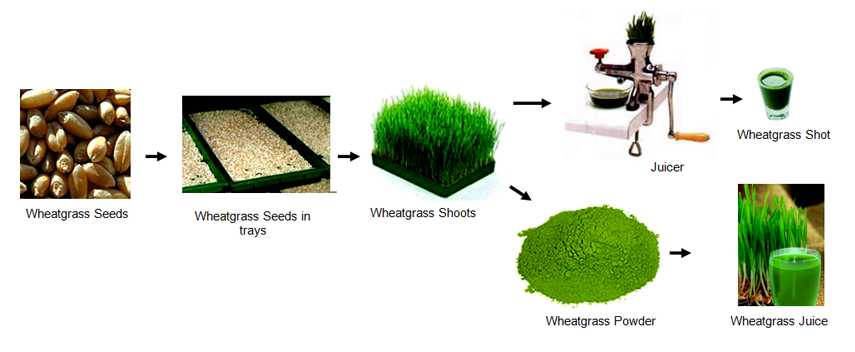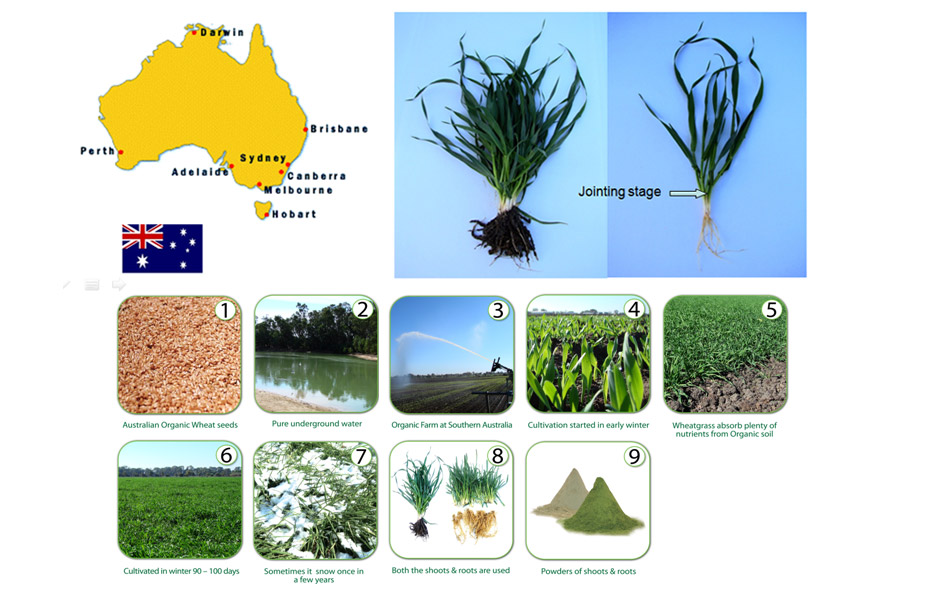|
|
|
|
ABOUT WHEATGRASS |
|
|
|
|
|
|
|
|
What is Wheatgrass? |
|
|
Wheatgrass is the young green plant that grown from wheat seeds.
According to The Wheatgrass Book written by Dr. Ann Wigmore, wheatgrass is an excellent source of chlorophyll, vitamins, minerals, amino acids, enzyme etc. It helps to detoxify the blood and expel toxin in the blood. The chlorophyll in the wheatgrass helps to bring in oxygen to the blood. It helps to build blood cells, very beneficial for anemia patients. The molecular structure of the chlorophyll is similar to that of the blood cells except that it is magnesium (Mg) element in the nucleus of chlorophyll and iron (Fe) in the nucleus of blood cell. The amino acids in the wheatgrass Helps to cleanse and regenerate kidney & liver, helps to improve immune system and also helps to slow down the aging process. The enzymes help in digestion and constipation problems. Wheatgrass also helps to improve metabolism and overall health condition. She had used wheatgrass to treat her patients for various diseases including cancers.
Swedish nutritionist and Nobel Prize winner Ragnar Berg, recommends a daily diet of 20% of meat (acidic food) and 80% of fruits and vegetables (alkaline food) to maintain a slightly alkaline pH of 7.3 – 7.4 in the body to fight diseases and to maintain a healthy body. This is because a lot of the diseases are caused by acidic body.
Source from Food Analysis Center of Japan reported that Wheatgrass has the top alkalinity among vegetables and fruits. |
|
|

|
|
|
|
|
|
Common methods to cultivate wheatgrass |
|
|
|
|
|
1. Grow at home indoor using soil or water |
|
|

|
|
|
Disadvantages: |
|
|
- Not exposed to natural sunlight and natural growing condition
- Takes only about 8 days to reach about 7 inches tall and harvest – limited nutrients
- Only shoots are used, roots are not used because it contains bacteria that are not
easy to remove away. The roots actually contains a lot of minerals and vitamins.
- Only juice, no fiber
- Taste not easy to accept
|
|
|
|
|
|
2. Grow commercially inside “Poly Houses” using little soil. |
|
|
 |
|
|
Disadvantages: |
|
|
- Not exposed to natural sunlight and natural growing condition
- Takes only about 8 days to reach about 7 inches tall and harvest – limited nutrients
- Only shoots are used, roots are not used because it contains bacteria that are not
easy to remove away. The roots actually contains a lot of minerals and vitamins. |
|
|
|
|
|
3. Grow commercially inside factory using water – ‘Hydro-phonic’ cultivation |
|
|
 |
|
|
Disadvantages: |
|
|
- Not exposed to natural sunlight and natural growing condition
- Takes only about 8 days to reach about 7 inches tall and harvest – limited nutrients
- Only shoots are used, roots are not used because it contains bacteria that are not
easy to remove away. Liquid fertilizer which contains chemical is often being used.
- Non-Organic
|
|
|
|
|
|
4. Rare Winter Cultivation Method: Cultivated during winter season in field |
|
|
|
|
|
Winter wheatgrass is the wheatgrass being cultivated on the natural soil or organic soil in the field in natural environment before winter and harvest after winter or early spring. When it grows to a height of about 4-5 inches the snow start falling and covers the wheatgrass throughout the winter During the extreme winter the temperature can be as low as below -7ºC. The wheatgrass grow extremely slow and almost hibernates at this stage. Even though it is not growing any taller but it is not dead, it has a very strong life. The wheatgrass absorbs plenty of sunlight and takes in abundant nutrients from the soil to fight against the coldness. The winter last for about 3 months and the wheatgrass has more time to pick up more comprehensive nutrients and produces stronger antibody. Since it is not growing any taller, most of the nutrients are being stored and accumulated in the wheatgrass. It will be harvested after winter or early spring after the snow melted and the wheatgrass grow to a height of about 8 -10 inches just prior to the “ jointing stage” “Jointing stage” is the period when the nutrients in the wheatgrass reach their peak concentration. (2) |
|
|
|
|
|
Analyses indicated that the wheatgrass can only produce normal root growth and leaf development in the natural environmental conditions only. (1) The wheatgrass leaves are rich in chlorophyll and the roots that were grown in normal natural environment are highly nutritious. The warm nature of the roots can neutralize the wheatgrass shoots which are cold in nature (the yin-yang effect). |
|
|
|
|
|
Source: The Cereal Grass Book by Ronald L. Seibold, M.S., The Wheatgrass Book by Dr. Ann Wigmore, Food Analysis Center of Japan, 'Die Nahrungs- und Genussmittel' by Dr. Ragnar Berg
References: (1) Gallagher, J., Biscoe, P., and Wallace, J. 1979. Field studies of cereal leaf growth.
Journal of Experimental Botany 30:657-668 (2) Kohler, G. 1944 The effect of stages of growth on the chemistry of the grasses.
The Journal of Biological Chemistry 152:215-223. |
|
|

|
|
|
|
|
|
The one and only Organic Winter Wheatgrass |
|
|
|
|
|
Our house brands YIGAHO and VINTER Organic Wheatgrass adopt the Winter Cultivation Method to produce one of the best Organic Wheatgrass in the world. Currently we may be the only company producing Winter Wheatgrass in the world as the cost of production is at least 5 times higher than those using common cultivation methods. This could easily be understood by the fact that we need to have a huge organic filed and takes 90 days or more to fully developed our wheatgrass till “jointing stage” which is the period wheatgrass has the highest concentration of nutrients. However, our retail price in finished products is about the same of that using common methods. This is because we practice mass production and also committed to benefit more human mankind at affordable price by sacrificing our profit margin to the lowest possible. Therefore it is truly a value buy and our Organic Wheatgrass is easily becoming the best selling wheatgrass in the countries that our wheatgrass is available. |
|
|
|
|
|

|
|
|
|
|
|
|
|
|
|
|
|
|
|
|
|
|
|
|
|





